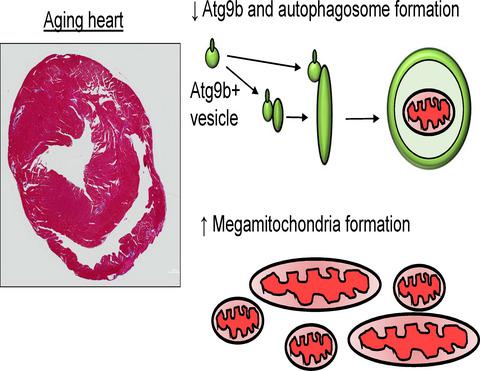当前位置:
X-MOL 学术
›
Aging Cell
›
论文详情
Our official English website, www.x-mol.net, welcomes your feedback! (Note: you will need to create a separate account there.)
Aging is associated with a decline in Atg9b-mediated autophagosome formation and appearance of enlarged mitochondria in the heart.
Aging Cell ( IF 7.8 ) Pub Date : 2020-07-06 , DOI: 10.1111/acel.13187 Wenjing Liang 1 , Alexandra G Moyzis 1 , Mark A Lampert 1 , Rachel Y Diao 1 , Rita H Najor 1 , Åsa B Gustafsson 1
Aging Cell ( IF 7.8 ) Pub Date : 2020-07-06 , DOI: 10.1111/acel.13187 Wenjing Liang 1 , Alexandra G Moyzis 1 , Mark A Lampert 1 , Rachel Y Diao 1 , Rita H Najor 1 , Åsa B Gustafsson 1
Affiliation

|
Advancing age is a major risk factor for developing heart disease, and the biological processes contributing to aging are currently under intense investigation. Autophagy is an important cellular quality control mechanism that is reduced in tissues with age but the molecular mechanisms underlying the age‐associated defects in autophagy remain poorly characterized. Here, we have investigated how the autophagic process is altered in aged mouse hearts. We report that autophagic activity is reduced in aged hearts due to a reduction in autophagosome formation. Gene expression profile analysis to evaluate changes in autophagy regulators uncovered a reduction in Atg9b transcript and protein levels. Atg9 proteins are critical in delivering membrane to the growing autophagosome, and siRNA knockdown of Atg9b in cells confirmed a reduction in autophagosome formation. Autophagy is also the main pathway involved in eliminating dysfunctional mitochondria via a process known as mitophagy. The E3 ubiquitin ligase Parkin plays a key role in labeling mitochondria for mitophagy. We also found increased levels of Parkin‐positive mitochondria in the aged hearts, an indication that they have been labeled for mitophagy. In contrast, Nrf1, a major transcriptional regulator of mitochondrial biogenesis, was significantly reduced in aged hearts. Additionally, our data showed reduced Drp1‐mediated mitochondrial fission and formation of enlarged mitochondria in the aged heart. Overall, our findings suggest that cardiac aging is associated with reduced autophagosome number, decreased mitochondrial turnover, and formation of megamitochondria.
中文翻译:

衰老与 Atg9b 介导的自噬体形成下降和心脏中线粒体增大的出现有关。
老龄化是发生心脏病的主要风险因素,目前正在深入研究导致衰老的生物学过程。自噬是一种重要的细胞质量控制机制,随着年龄的增长在组织中会减少,但自噬中与年龄相关的缺陷的分子机制仍未得到很好的表征。在这里,我们研究了自噬过程在老年小鼠心脏中是如何改变的。我们报告说,由于自噬体形成的减少,老年心脏的自噬活性降低。用于评估自噬调节因子变化的基因表达谱分析发现 Atg9b 转录物和蛋白质水平降低。Atg9 蛋白对于将膜输送到不断增长的自噬体至关重要,和 siRNA 敲低细胞中的 Atg9b 证实了自噬体形成的减少。自噬也是通过称为线粒体自噬的过程消除功能失调的线粒体的主要途径。E3 泛素连接酶 Parkin 在标记线粒体以进行自噬中起关键作用。我们还发现老年心脏中 Parkin 阳性线粒体水平增加,这表明它们已被标记为线粒体自噬。相比之下,线粒体生物发生的主要转录调节因子 Nrf1 在老年心脏中显着降低。此外,我们的数据显示,在老年心脏中,Drp1 介导的线粒体裂变减少和扩大的线粒体形成减少。总体而言,我们的研究结果表明,心脏衰老与自噬体数量减少、线粒体更新减少和巨线粒体形成有关。
更新日期:2020-07-06
中文翻译:

衰老与 Atg9b 介导的自噬体形成下降和心脏中线粒体增大的出现有关。
老龄化是发生心脏病的主要风险因素,目前正在深入研究导致衰老的生物学过程。自噬是一种重要的细胞质量控制机制,随着年龄的增长在组织中会减少,但自噬中与年龄相关的缺陷的分子机制仍未得到很好的表征。在这里,我们研究了自噬过程在老年小鼠心脏中是如何改变的。我们报告说,由于自噬体形成的减少,老年心脏的自噬活性降低。用于评估自噬调节因子变化的基因表达谱分析发现 Atg9b 转录物和蛋白质水平降低。Atg9 蛋白对于将膜输送到不断增长的自噬体至关重要,和 siRNA 敲低细胞中的 Atg9b 证实了自噬体形成的减少。自噬也是通过称为线粒体自噬的过程消除功能失调的线粒体的主要途径。E3 泛素连接酶 Parkin 在标记线粒体以进行自噬中起关键作用。我们还发现老年心脏中 Parkin 阳性线粒体水平增加,这表明它们已被标记为线粒体自噬。相比之下,线粒体生物发生的主要转录调节因子 Nrf1 在老年心脏中显着降低。此外,我们的数据显示,在老年心脏中,Drp1 介导的线粒体裂变减少和扩大的线粒体形成减少。总体而言,我们的研究结果表明,心脏衰老与自噬体数量减少、线粒体更新减少和巨线粒体形成有关。



























 京公网安备 11010802027423号
京公网安备 11010802027423号